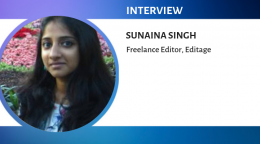The future of publishing: New tools to make the publication process smoother

Matias Piipari is the CEO and co-founder of the recently launched Manuscripts, an app that helps researchers write and easily navigate and structure complex research papers. Matias is also the CTO of Papers, the makers of a reference manager tool popular among researchers (founded by Alexander Griekspoor, the other co-founder of Manuscripts). After a PhD in molecular biology at Cambridge, during which he built mobile software and tech consulting projects as part of a company he started at the time, Matias has been involved in creating innovative solutions for the academic research community. His graduate research dealt with large-scale machine learning methods for identifying gene regulatory signals.
In this conversation, Matias tells us more about Manuscripts and how it helps researchers from the earliest stages of preparing a research outline to the later stages of preparing a submission-ready journal article. The highlight of Manuscripts is its feature that allows authors to manage large manuscripts without disrupting the structure. The organization helps authors focus on writing instead of worrying about other potentially distracting aspects such as formatting. Matias also shares some interesting views on the advancement and use of technology in present-day academic publishing. He emphasizes that researchers and publishers should be open to trying out new tools that will introduce efficiencies in writing and publication.
Could you begin by telling our readers more about Manuscripts? What is it and how can it help researchers?
Manuscripts is a user-friendly writing tool that helps authors create and manage complex scholarly documents, from outlining and writing a research paper to editing and proofreading it as well as putting it through the publishing stages.
The truth is that research writing is a huge task. Not only do authors have to organize their thoughts, but they also have to ensure that they present sufficient proof of their work by creating reference lists, tables, figures, etc. And journal submission brings in the additional details of styling, formatting, etc. The central problem Manuscripts solves is ensuring that throughout these numerous stages, authors are able to focus on the substance of their story (their research) as opposed to getting distracted by mechanical tasks. Manuscripts helps authors plan, write, navigate, and edit a complex paper without getting lost in the document; authors using Manuscripts also don’t need to deviate from their natural writing flow to jump into a variety of external tools.
Manuscripts offers a complete scholarly writing experience in a single app: multi-panel figures, table editing, equations as well as a top-of-the-line citation workflow. It also includes over 1,000 journal-specific manuscript templates to give authors a starting point for writing their articles. (We expand this database regularly and are seeking publishers to collaborate with.) The tool takes care of the obvious and not-so-obvious aspects of using journal paper templates, e.g., maximum word counts and acceptable figure formats. Papers created on Manuscripts can be exported to Word, LaTeX, and Markdown formats. It also allows authors to import external files (in multiple formats) on to the app. While using the app authors don’t really need to understand paragraph styling or clean typesetting markup in LaTeX. In essence, Manuscripts is a word processor re-imagined to perform a bulk of mechanical formatting on behalf of authors, so that they can focus on getting the actual writing work done. Overall, we help both authors and publishers by ensuring that documents created using Manuscripts are of a certain minimum technical quality.
Matias, there are several authoring tools and apps available to researchers today. What makes Manuscripts special? How will it change the publication landscape?
Manuscripts stands out because it combines in one app features that haven’t yet been made available by other writing tools. To elaborate, Manuscripts is a stand-alone, fully offline-capable, rich-text writing tool (i.e., authors don’t need to write in a Web browser) that allows users to import and export MS Word, Markdown, and LaTeX formats; it also retains the full version history of a document. Manuscripts is not a text editor that offers a minimal set of features. It is also not an MS Word clone; it is actually a new type of writing tool. For instance, the app can also be used to write non-Latin documents.
Setting aside the technical features of the app, we are striving for something bigger – the most streamlined user experience imaginable for authors. Manuscripts offers an extremely polished, task-focused experience that authors connect with. We’ve been receiving positive feedback from authors about the look and feel of the tool. This is absolutely essential for motivating writers - who are accustomed to tools such as MS Word, text editors for editing LaTeX, and Markdown - to try out newer tools. We think that new tools that make the publication process smoother are a big part of the future of academic publishing.
How can different people in academia benefit from Manuscripts?
The focus on usability makes Manuscripts particularly appealing to writers from non-technical backgrounds. Although many of our users are from the biomedical sciences, the app has been designed to work for a wide range of disciplines including psychology, geography, engineering, mathematics, physics, and computer science.
Manuscripts also has a wide user base outside of academia. The app is used for preparing school essays, blog posts, legal documents, or company whitepapers because it is a tool that understands the structure in any type of content, enforces word count limits, and, most importantly, helps the writer focus better. In fact, we already have a number of non-academic book authors amongst our early adopters, and as we grow, we expect our user-base to diversify. And as far as global uptake is concerned, thus far, we have seen a lot of usage by authors not just in US, Canada, and European countries but also in Japan, Korea, and China.
How user-friendly is the app interface? On the support section of your website, you say that users of Manuscripts “will not find half a dozen ribbons of nonsense like in MS Word from Manuscripts.” Could you elaborate on this?
The reason we eliminated many ribbons and character styling options available in tools like MS Word is that good writing is all about consistency. A visually consistent, and beautiful, representation of your writing on the screen helps you focus on the consistency of your writing. And despite omitting the multitude of styling options, Manuscripts is a very powerful tool and its capabilities are applied to features like paragraph styling for different parts of a document. For instance, in Manuscripts, headings are never marked as bold text, and you cannot add spaces between elements with tabs or additional line breaks – we believe this to be counterproductive for both authors and publishers. The bottom line is that writing or editing tools can help with the visual representation of a document, but a paper must be well structured. Only then can authors focus on what they are good at, i.e., formulating their argument or telling their story.
Matias, many authors actually prefer and are accustomed to using MS Word for their writing work, and they may not be confident about using a tool that excludes many of the features offered by MS Word. Do you see this as a problem?
First, Manuscripts offers great Word interoperability and we do not ask our users to leave Word behind: we both import and export Word documents, citations and equations included. We also do not exclude formatting options as much as we help the author think in a form where the formatting follows from the meaning of what is being written. That means the user can think on the level of writing content, and gets the formatting done as a bonus. For instance, section headings, body paragraphs, block quotes, equations all have a pre-defined look that you can edit if you like, but with Manuscripts, you only do so whilst maintaining the overall consistent look to the article. This means that you lose many formatting options as character level features, to gain these styling options instead in a consistent form across your article. This is proving a very intuitive way to think about formatting an article for our users. We do of course receive suggestions for improvement, but the basic concept is really a big hit and the feedback really concerns the details and the extent to which we are able to automatically format the document.
Second, the academic writing landscape is not really quite as uniformly MS Word-based as the publishing industry tends to think: often, all content is required to be submitted in .docx form. That the publisher receives a Word file does not mean the author actually used MS Word to create it. The majority of people of course write in Word, many others in LaTeX, but there are also people writing in simpler markup formats like Markdown, which can also be used to produce Word files as an output. We help writers using all three kinds of platforms: word processor, LaTeX, and Markdown. We also do not ask the user to be “exclusive” to Manuscripts in any way as we interoperate with all these three major formats.
Third, Word is a very commonly used tool, and I don’t dispute that some people even may like using it. But I doubt there are many academic authors using MS Word who really feel comfortable with the multiple buttons offered in the toolbar or the complex and fairly hidden form in which the styling options take form in Word. Word is a common tool in part because it is often found pre-installed on systems and because it is the most obvious choice of tools but we certainly see the demand for Manuscripts to be because people are actively looking for alternatives.
Citation (presenting and formatting) and citation linking are critical aspects of manuscript writing, tracking, citing, and impact measurement. To what extent does Manuscripts help researchers manage their citations better?
Manuscripts includes an entirely open interface for working with citation tools. Today, at the 1.0 launch, Manuscripts works in a highly integrated way with the Papers reference manager using this interface. It also imports bibliographic data from key formats (e.g., BibTeX, EndNote XML, and RIS) and has a built-in citation tool so you can really use any referencing tool of your choice with it.
The app’s reference management capabilities will grow. Although we will need external reference managers, for many projects (especially those for undergraduate writing) Manuscripts will offer comprehensive citing tools for writing project.
In scientific research and publishing, technology is becoming more and more responsive to the needs of users (researchers, authors, publishers, and readers). New tools are being created to introduce efficiencies at various stages of research. Are researchers aware of these tools? How effectively are they using them? Also, do you think there are differences in how these tools are used by researchers/authors in different parts of the world and at different stages of their career?
As far as the adoption of newer tools to help paper creation and publication is concerned, there's definitely a big difference depending on the field and seniority of researchers. We expect Manuscripts to appeal to researchers at all levels and from all fields. Writing is something that researchers and students need to start at an early stage when, for instance, getting references right may not be emphasized as much as getting the story, document structure, and length right. Incidentally, these are tasks that conventional word processors do not support directly.
I think researchers prefer using tools that are easy-to-use, because they value their time and are, to some extent, still fairly conservative about adopting new workflows and tools. In my opinion, this level of ease of use is currently under-appreciated in the publishing world; as a result, we underestimate the extent of time and effort that these tools can help us save. Such tools help both researchers and publishers by making the publication process more effective. At any case, with Manuscripts, we want to provide a tool that stands the test of time and is not built to fit a certain trend in the publishing industry.
As I understand it, the current version of Manuscripts is being released for Mac systems (Manuscripts requires Mac OSX Yosemite, 10.10, or later). Will this limit your user base? Do you plan to make the app available on other platforms as well, such as Manuscripts for Windows, Manuscript for Web, Manuscripts for smartphones, etc.?
Building a great product, like writing an effective paper, requires focus. Our focus has been on proving the concept and building something beautiful and usable, something that allows us to iterate very quickly to early adopter feedback (we have been shipping beta updates on an almost daily basis, for instance). For that reason, the release of Manuscripts 1.0 was targeted at Mac users only. The response we have received validated our choice: we have an extremely enthusiastic group of early Manuscripts adopters who spread the word, and word-of-mouth marketing is what we plan to use to grow the business.
But a Mac release is really just the beginning. We spent a good three years building Manuscripts, and this was partly because we wanted to begin with building the technology into a form that could be ported across to the Web and other desktop platforms, including the iPad.
What else can users expect from Manuscripts in the near future?
We have planned a steady stream of updates to release a number of new features, including those that allow us to support more fields. We have enabled an experimental right-to-left mode, and we will work on it based on feedback from our users. We may even consider releasing localized versions to help authors from non-English countries. However, the biggest development to look forward to is our collaborative writing feature. Supporting collaboration is the most common request we receive from our users. This is something we are excited about and have already started building. In fact, the current version of Manuscripts allows full version control because of the upcoming collaboration features.
We believe that it is essential to enable online collaboration and simultaneously provide an offline experience. In my opinion, the present set of collaborative scientific writing tools enforce a compromise between personal productivity and the need to write collaboratively, and we believe that through Manuscripts, we can offer something unique.
Thank you, Matias!
Matias also shared a video that shows how authors can use Manuscripts to their advantage:
Published on: Jan 20, 2016
Comments
You're looking to give wings to your academic career and publication journey. We like that!
Why don't we give you complete access! Create a free account and get unlimited access to all resources & a vibrant researcher community.







